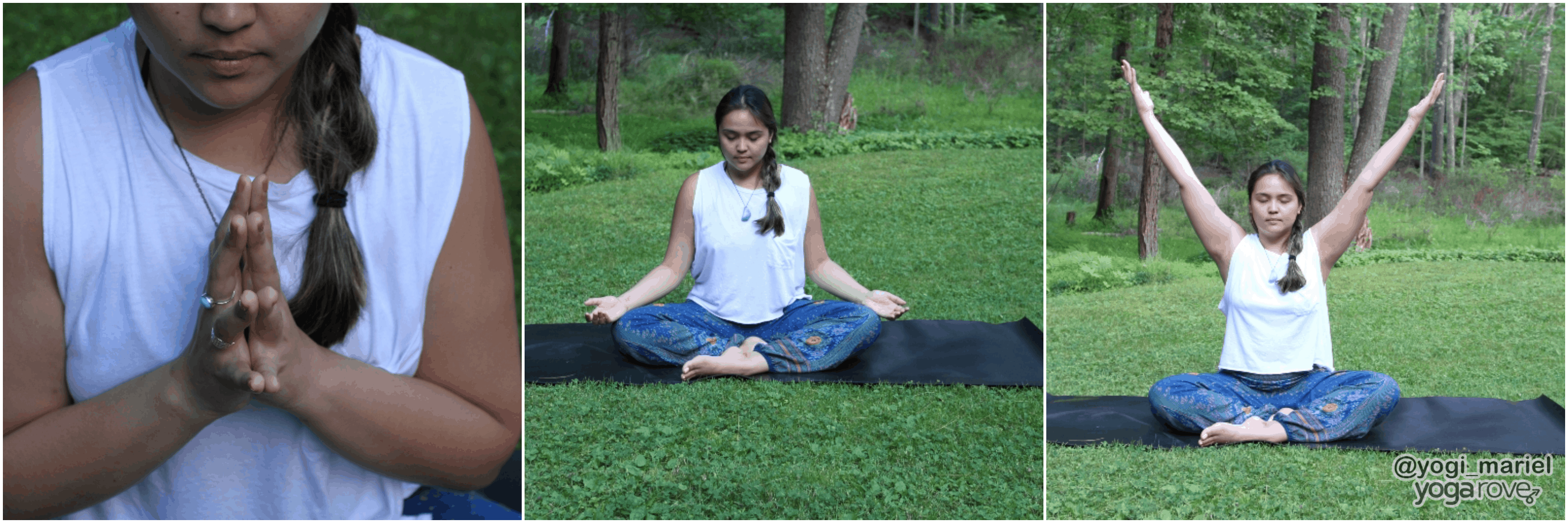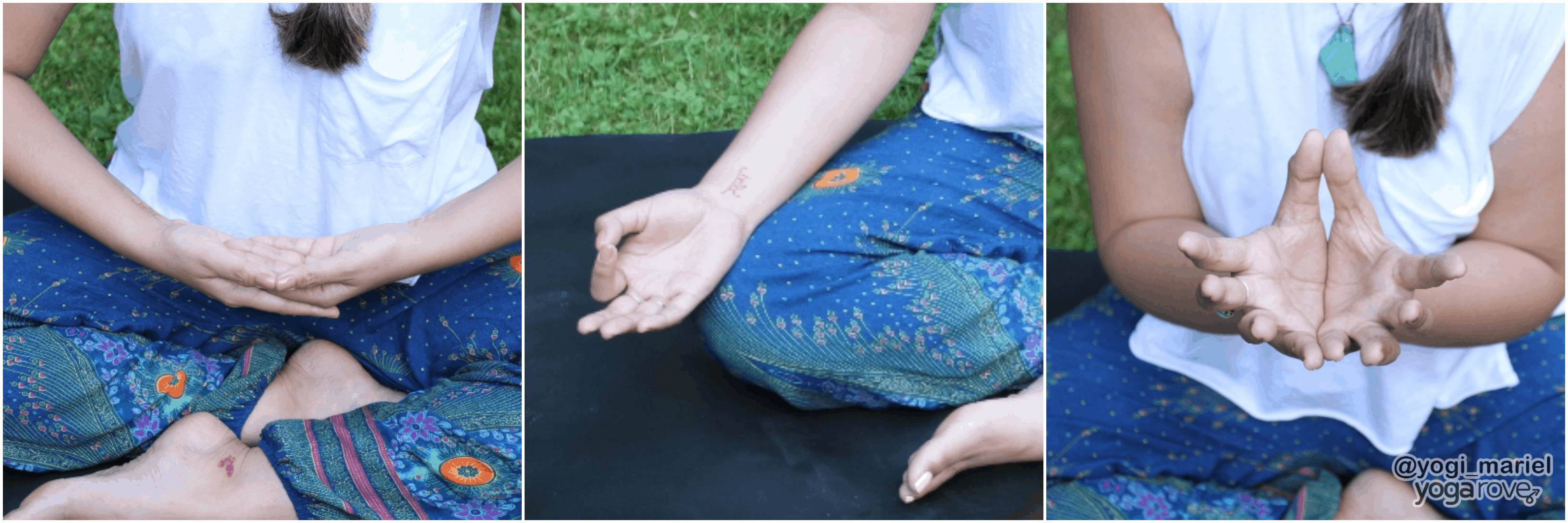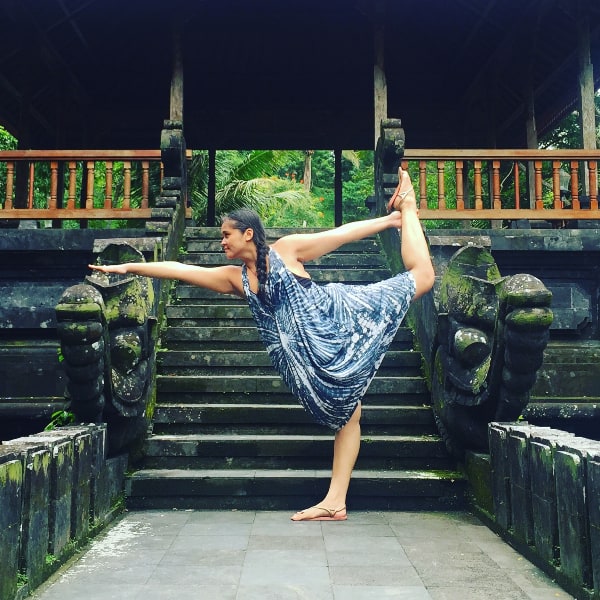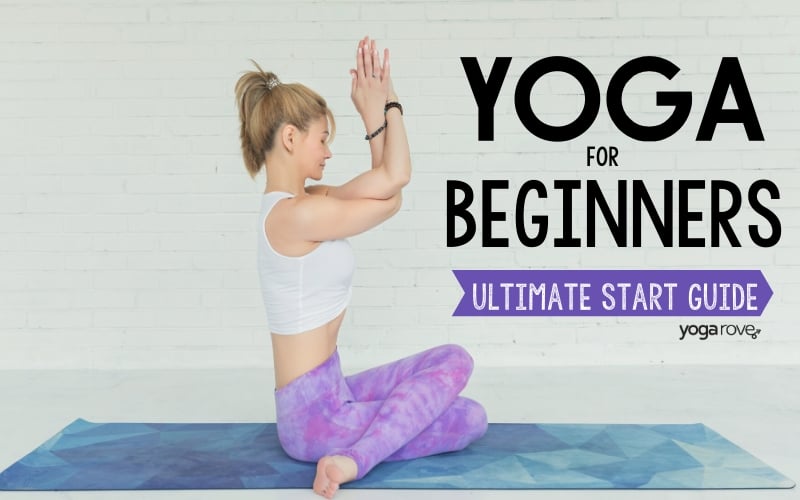This post may contain affiliate links. Please read our disclosure for more info.
Many yoga practitioners naturally find themselves gravitating toward a meditation practice or vice versa. Yoga itself is a moving meditation, with breath and body linking together to form a meditative physical practice. In your meditation practice, you may find similarities in your yoga practice, including different poses. So what are the best yoga poses to practice while meditating?
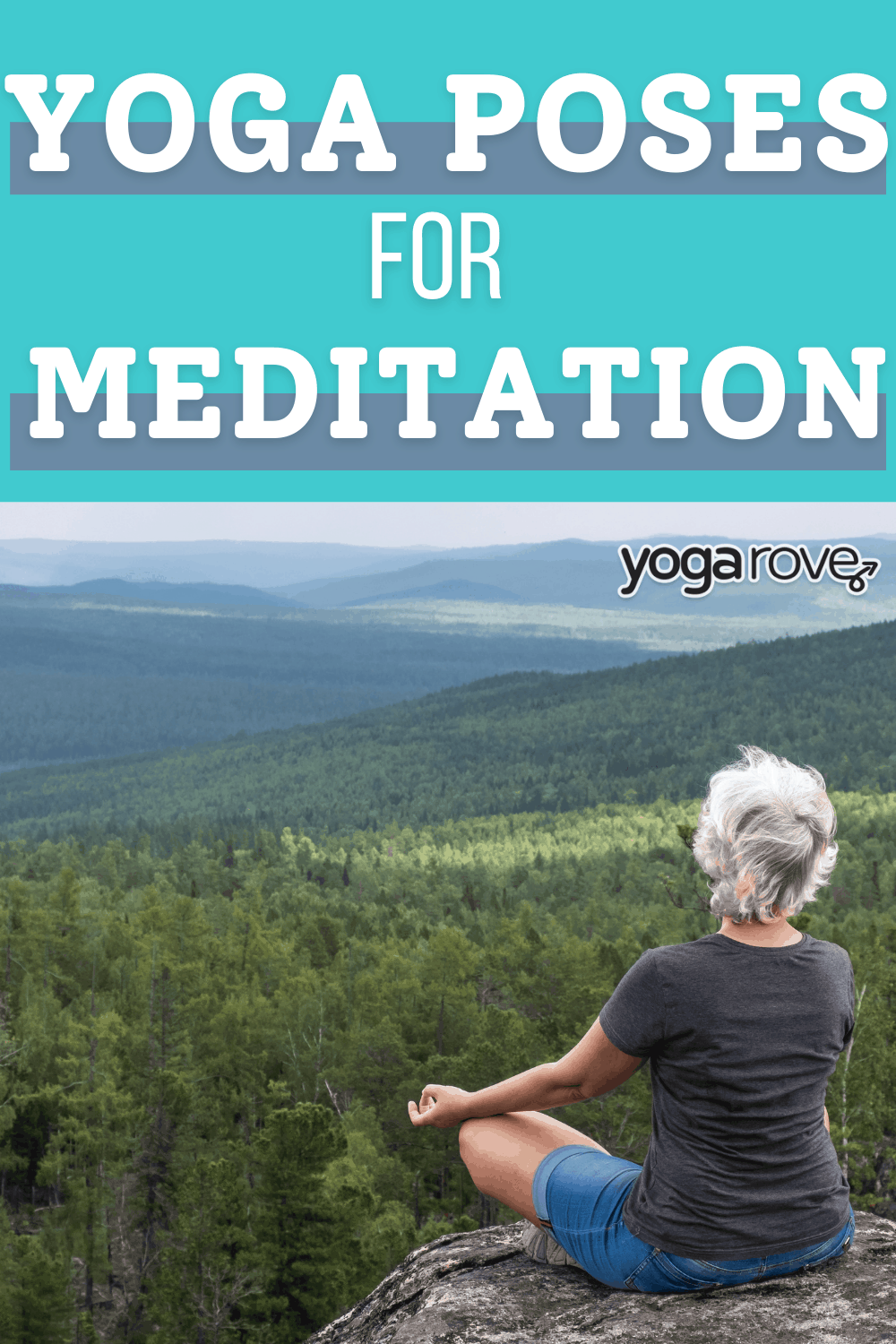
There are numerous postures that you can choose from for your meditation practice. From sitting to a chair to sitting on the mat in full lotus, there are different shapes that you can choose to practice depending on your comfort level and flexibility. Choose a pose that you can relax into while keeping proper alignment and a long spine.
Meditation Benefits
More and more people are turning to more holistic ways to deal with the daily stress of life. From yoga classes, plant medicine, and meditation— this movement is definitely not slowing down. If you are an avid meditator or a meditation newbie, perhaps you already know about the numerous benefits that a regular meditation practice has on the mind and the body.
Meditation can:
- Help to reduce depression and anxiety
- Develop your self-awareness and consciousness
- Create a sense of calm, peace and balance
- Reduce stress
- Increase energy
Meditation Basics
A great supplement to your health and wellness routine, mediation is a practice that more and more people getting into. Meditation studios are growing in popularity and lots of yoga studios offer meditation classes to their students. You can practice meditation in a group or class setting, or in the comfort of your own home for a few minutes a day.
When beginning your meditation practice, start by sitting for a few minutes in a quiet and peaceful space. Slowly, you can begin to sit for longer periods of time as you go deeper into your practice. Try downloading a meditation app or watch guided meditation videos if you are learning this practice on your own.
Different Types of Meditation
With so many benefits, it is no wonder that interest in meditation is growing. But which type of meditation practice is the best for you? Similar to yoga, there are different practices and lineages of meditation. Some are focused on the breath, while others include chanting, mantras, visualization, or breathing techniques. If you are new to meditation, it can be beneficial to try a few styles before you decide on a practice that resonates with you.
Some styles of meditation include:
- Guided: With this type of meditation, a meditation guide or teacher will lead you through your meditation with different words and imagery. You can practice this type of meditation in a class, from an app, or even on YouTube. Guided meditation promotes deep relaxation and reduces stress.
- Mindful: Mindful meditation teaches you to watch your breath and your thoughts. It creates acceptance and allows you to practice being in the present moment without any judgment. This type of practice is known to reduce anxiety and anxious thoughts.
- Mantra: In this type of meditation, you chant or recite different mantras (often Sanskrit) over and over again. Each mantra carries a specific energy and intention and this practice can be very strong and powerful.
- Sound: A sound meditation is a beautiful practice that brings you to the present moment. You may meditate listening to crystal bowls, gongs, or other soothing sounds. Sound meditations or sound baths are becoming more popular around the country and may include breathing exercises or guided meditation as well.
How Can I Sit Longer in Meditation?
We all know that all too familiar feeling during meditation— suddenly your legs start to fall asleep and your feet go numb. You begin to feel your back muscles getting tired, and a good stretch sounds so much better than sitting in your easy pose for another 10 minutes. Soon your mind starts to wander and you start thinking about what you are going to eat for dinner.
Often, physical discomfort or mind wandering can cause you to shorten your meditation practice. You may be wondering how you can start to train your body and mind to stay longer in meditation. It definitely takes time, practice, and patience to build up your practice,
Meditation Tips
If you would like to sit for a longer period of time or find more comfort while meditating, remember that meditation is a practice. It takes time to build up the physical and mental muscles that you use to meditate.
Here are some meditation tips that you can try:
- Use props: Whether it’s a blanket, blocks, or a meditation cushion—allow yourself to be comfortable. Use your props to provide more support for your body. Sometimes a little more height or cushioning can make all the difference.
- Find the best pose for you: We all have different bodies so if you find that a particular pose does not feel comfortable, change your posture to find one that does. This may be sitting in a chair, on the ground, or even laying down on your back. If you lay in Savasana and find yourself falling asleep, it may be a good idea to practice in an upright position
- Stay connected to your breath: Falling asleep or drifting off with your thoughts? Stay with your breath and allow your inhales and your exhales to ground you in your practice. It is totally normal to have the mind wander, and you can use your breath to come back into the present moment.
- Set an intention: Often intentions can carry us through our practice. Before you start meditating, you can choose to set an intention for your practice. What is it that you want to cultivate, let go of, or manifest?
- Try a group class: In many cities, there are group meditation classes and even meditation studios that you can attend. Give a few classes a go and see which type of meditation, studio, or teacher resonates the most for you.
Best Yoga Meditation Poses
The ‘best’ meditation pose is different for every body. If you have tight hips or lower back pain, it may be more comfortable for you to meditate on a chair or on a meditation cushion. Because there are many poses that you can practice while meditating, it is a good idea to try a few postures before finding a few that feel great in your body.
Hero Pose
Virasana, or Hero pose, stretches and strengthens many parts of your body and is a great pose to meditate in. If you have ankle or knee injuries, take caution when coming in and out of the posture, and feel free to modify and use props as you see fit. This pose stretches your ankles, thighs, and knees, and strengthens the arches of your feet.
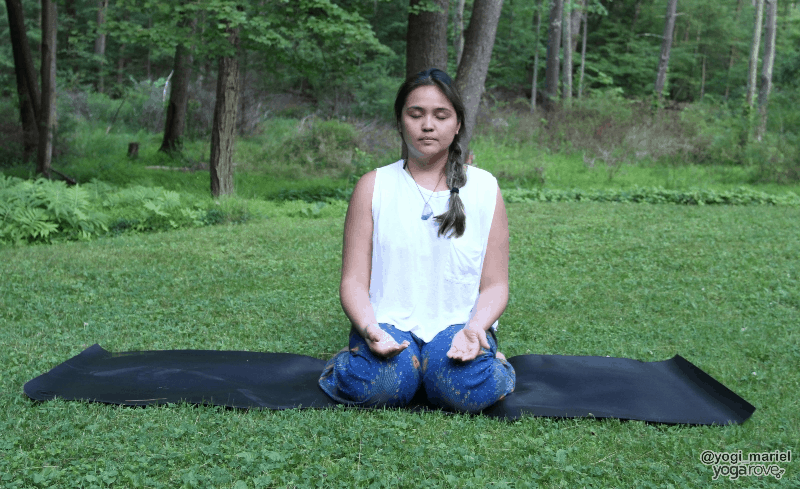
- Begin sitting on your heels with your knees together at the center of your mat.
- Lift your hips off of your heels and take your heels apart so that you can rest your sit bones in between your heels.
- Check that your toes are pointing straight back and that your hips and heels are touching.
- Very gently begin to rest your sit bones in between your heels, keeping your knees together.
- Place your hands on your knees, straighten your elbows, and soften your fingers.
- Find a straight spine and engage your core by drawing your belly button in toward your spine.
- Tuck your chin in slightly to your chest to keep the back of your neck long. Roll your shoulders up, back, and down, and engage your upper back to lift your chest, while relaxing your shoulders away from your ears.
Here are some tips for practicing Hero Pose:
- If your sit bones are far from the mat, stack one or two blocks in between your heels and sit on your block instead.
- If your ankles feel uncomfortable, roll up a blanket and place it underneath your ankles for more support.
Lotus Pose
A picture of lotus pose, or Padmasana, instantly conjures up an image of yoga. This classic, but challenging pose, is the go-to for ancient yogis during meditation and requires extremely open hips and ankles. It can take years to master this posture, but with consistent practice, you can open up your body to staying in this posture during meditation. If this posture seems very challenging to practice, try a quarter or half-lotus variation to begin to open up your body to the full lotus pose.
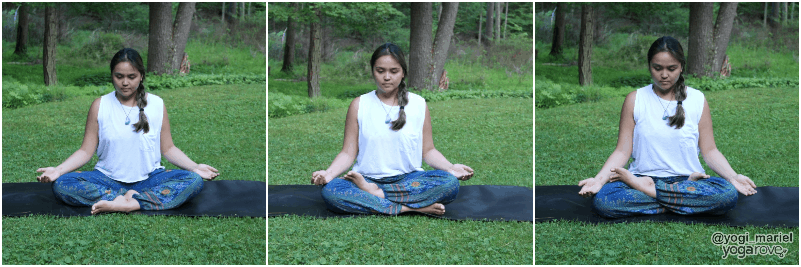
Quarter Lotus
- To practice quarter lotus, follow the same directions as easy pose.
- Instead of placing your foot to rest underneath your opposite knee, you can cross your ankles in front of you.
- The more your hips and ankles begin to open, you can process to a half-lotus variation.
Half Lotus
- Begin sitting on the mat with both of your legs out long in front of you.
- Bend your right knee up toward the ceiling, and using your hands, very gently lift your leg up and open your knee out to the side to open your hip.
- Gently place your foot toward your left lower belly and take the sole of your foot perpendicular to the floor.
- Bend your left knee and take your foot in front of your right shin, as if you were practicing a quarter lotus.
- Place both of your hands on your knees, straighten your spine, and relax your shoulders away from your ears.
- Keep your chest open and your collar broad, and feel your hips heavy on the mat.
Full Lotus
- Follow the directions for half lotus, however, once you get to Step 3, bend your knee, lift your leg, and open the hip.
- Follow Steps 2-3 of Half Lotus on the opposite leg.
- Cross your shins and relax your toes, while keeping your heels close to your stomach.
- Keep your knees and hips heavy to the floor while lifting your upper body out of your waist.
- Find your straight spine, relaxed shoulders, and broad collar.
Here are some tips for practicing Lotus Pose:
- Be patient if you are working toward a full lotus pose. Stay in the variation that feels the most comfortable and start to work up to a few minutes in each.
- When you find that you can sit comfortably, you can start to progress to half or full lotus.
- Make sure that you practice lotus pose on both sides. If you usually lift your right leg up first and bend the knee, be sure to counter by taking the pose by practicing a second time with the left leg bedding in first.
- Try to relax your ankles and your toes while you are in the posture.
Easy Pose
A great beginner’s pose for meditation, Easy pose is a very accessible posture for many yogis to get into. This posture builds up the muscles in your upper back and stretches your ankles, hips, and knees. If you require a little extra support, you can use a wall behind you.
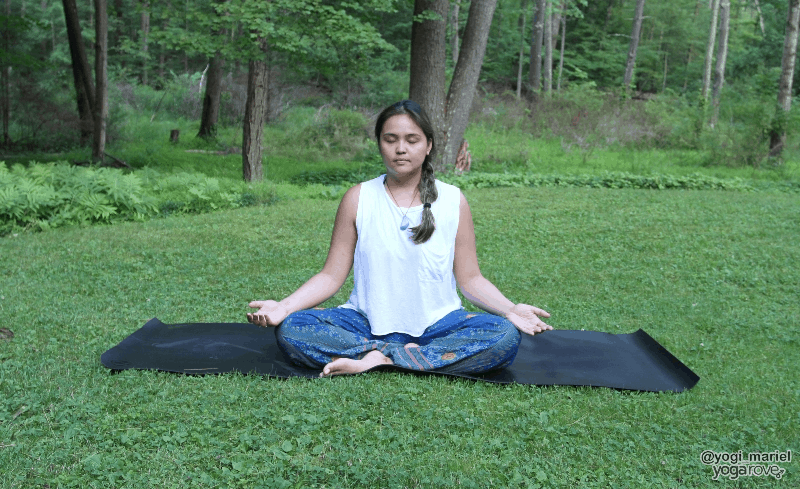
- Sitting at the center of your mat, bend both of your knees and cross your shins.
- Place each foot underneath the opposite knee and relax your knees down toward the floor.
- Feel yourself rooting down to the mat with your sit bones. Allow your thighbones to be heavy and relax your hands on your knees.
- Lift your upper body out of your waist as your lengthen your side body and relax your shoulders away from your ears.
- Keep the shoulders soft but collar broad, and tuck your chin down slightly to your chest to keep the back of your neck long.
Other Meditation Postures
Some yogis prefer to meditate in a chair or laying down in Savasana. The key to a great meditation posture is a pose in which you are relaxed with good alignment— but not too relaxed that you fall asleep! If you find that meditating in Savasana causes you to drift off, try practicing in Easy pose or on a chair. If you choose to meditate in a chair, use a chair with a straight back and no arms, and with a straight spine, keep your feet firmly rooted on the floor.
Arm + Hand Variations for Meditation Yoga Poses
There are numerous variations for your hands and your arms that you can practice while meditating. Depending on your intention for your practice, your hands can take the shape of a specific mudra, or seal, during your practice.
Practiced in Hinduism and Buddhism, mudras are energetic seals that are practiced during meditation or pranayama exercises. They hold different energies and intentions, and can help to manifest the energy that you want to bring into your life. Many people practice mudras during meditation to deepen their practice and center their energy.
If you are not sure which mudra or arm variation to practice, try out a few during your meditation practice to see which resonates with you the most. You can also practice different mudras depending on the intention of your specific meditation practice.
Prayer Hands
Take your hands together and gently press your palms together to touch. Spread your fingers slightly apart to that there is not too much tension keeping your fingers together. Roll your shoulders up, back, and down, and lightly rest your thumbs to your heart center.
Palms Up
Resting your hands on your knees, flip your palms to face up toward the sky. Relax your fingers and your wrists and keep your chest open, spine straight, and shoulders relaxed.
V Arms
Lift your arms up over your head and take them out into a V-shape. Spread your fingers wide, take your palms to face each other, and feel energy radiating out of your fingertips. The shoulders may come up toward the ears here, so be sure to soften your shoulders and keep your chest open.
Dhyana Mudra
Bend your elbows and take your hands in front of your lower belly. Place one hand on top of the other, as if you are gently holding something in the palm of your hand. Your thumbs can lightly touch as you rest your hands on your lap.
Chin Mudra
Place your hands on your knees with your palms facing up to the sky. Take your thumb and your pointer finger to touch and relax your 3 other fingers. Keep the contact of the thumb and pointer finger soft and light.
Lotus Mudra
Lift your hands up to your chest and take your baby fingers and thumbs to touch. Open the rest of your fingers as if you are creating a bowl with your hands. Keep your elbows hugging in close to the sides of your body and your thumbs in front of your heart center.
Related Questions
Do I need to sit on a meditation cushion when I practice meditation? Meditation cushions are great to use during your practice, but not mandatory during practice. You can sit on your block, rolled-up blanket, or a chair, if you prefer.
How much pressure should I use when holding a mudra? Mudras are all about the flow of energy, so you should allow the seal to be present without holding too much tension in your muscles. Allow your fingers and hands to be relaxed, while keeping the shape of your mudra.


